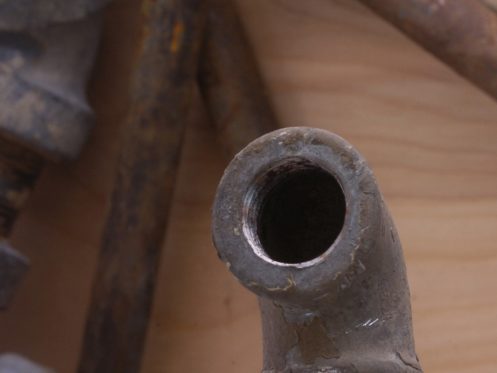If you’ve got a rusty furnace at your home in Denver, you should call an HVAC technician right away. When rusting is severe and widespread, it can undermine the integrity of key heating system components. More importantly, it can leave everyone in the home at risk of being exposed to harmful combustion gases. The following are five reasons why furnaces rust along with a few tips for preventing this all-too-common issue.
1. You Haven’t Been Maintaining Your Air Conditioner
Having your air conditioner regularly serviced by licensed HVAC professionals is about far more than extending the life span of your cooling equipment. Most air conditioners are installed right next to or directly over furnaces. When their condensate lines get blocked or clogged or when their drain pans are damaged, air conditioners can leak water onto heating equipment nonstop. When homeowners see standing pools of water around their furnaces, they often suspect furnace damage. However, more often than not, these pools are collected water from the cooling units that sit just next to or above the furnaces.
Anything that creates standing water on or around your furnace is a gateway to rust. Schedule annual service visits to have your air conditioner inspected, cleaned, and professionally maintained. This will ensure that problems like blocked drains or cracked drain pans don’t have the opportunity to spiral and that they won’t affect your furnace.
2. You Need to Improve Your Drainage
Rainwater may be entering low-lying areas of your home if your downspouts aren’t working properly or if they aren’t installed to effectively route water away from the building. Check the area around your furnace for standing bodies of water on a regular basis. If your furnace is installed in a perpetually wet basement, consider the benefits of having a sump pump put in.
While poor outdoor drainage and air conditioner leaks are often responsible for pooling water at the furnace, this can also be the result of leaky pipes or leaky appliances that are installed nearby. A slow, hidden leak at your washing machine’s connections can even be the culprit. The best strategies for avoiding rust-causing issues like these include:
- Upgrading your downspouts
- Installing better in-floor drainage
- Scheduling a yearly whole-house plumbing inspection
Letting slow or hidden leaks fester can diminish the life span of your furnace. Whole-house plumbing inspections allow plumbers to identify hidden leaks behind drywall and appliances. During these visits, plumbers can also spot damaged pipes and other inconspicuous issues that might cause costly damage to both your furnace and to nearby building materials. Finding and resolving slow and hidden leaks as soon as possible will limit your repair costs, keep you in compliance with the terms of your homeowner’s insurance, and keep rust at bay. It can even lower your water bills. Once rust sets in, the feasibility of repairing damaged furnace components versus replacing the entire unit declines significantly.
3. The Venting System for Your Furnace Is Damaged
A damaged venting system is a serious problem. If the flue that carries combustion gases out of your home is compromised in any way, escaping gases and vapor could cool down and turn into condensate before they’re actually released. When the vent system is damaged, rust can also affect the furnace’s heat exchanger. Rust in either of these areas can greatly increase the likelihood of exposure to:
- Carbon monoxide
- Nitrous dioxide
- Sulfur dioxide
When combustion gases enter the living space, residents may initially feel nauseous and headachy. The symptoms of exposure will heighten as the problem is prolonged. Worse still, if carbon monoxide isn’t detected early on, it can lead to serious and potentially permanent health issues for both human residents and pets. Prolonged carbon monoxide exposure can even result in death. This is the best reason for contacting HVAC professionals whenever furnace rust is suspected. In this case, rust may be a symptom of a serious combustion problem. When gas is used to create heat energy, vapor is produced. If both the venting system and the heat exchanger are working correctly, this vapor shouldn’t turn into condensation that accumulates and eventually creates rust.
HVAC professionals can thoroughly inspect all venting system components and your furnace’s heat exchanger to determine the severity of the problem. If necessary, an all-new venting system can be put in. If rust at and around the heat exchanger is extensive, you may need to have a new furnace installed. Your provider will consider the age and overall condition of your furnace and make recommendations for solving the problem that provide the greatest level of safety.
4. You’ve Got an Overly Humid Home
Rust-causing moisture doesn’t always come in the form of visibly pooling water. Sometimes, the indoor air is simply too humid. This may be the case if you have a large and incredibly active household or if you do a lot of indoor cooking. If you regularly have condensation on your windows or on other interior surfaces, your furnace is likely suffering the ravages of excess moisture, too. Installing a whole-house dehumidifier is both a great form of rust prevention and an effective way to keep issues with mold and mildew at bay. Not only will your furnace remain corrosion-free a lot longer, but your indoor air quality will improve as well.
5. It’s Time to Replace Your Furnace
A well-maintained furnace that’s been professionally installed will likely last for 10 years or even longer. Throughout this time, diligent efforts to limit moisture on and around this unit can keep serious problems with rust at bay. Unfortunately, however, it’s not possible to keep furnaces absolutely moisture-free all of the time. As the years go by, some manner of rust will likely develop on this unit. When rusting is an age-related issue rather than an environmental one, your HVAC service provider will likely recommend replacing your furnace.
Although your furnace might be working just fine, replacing it due to rust can be an incredibly cost-effective decision. Older furnaces are much less efficient than units that are brand-new. In fact, efficiency losses are often progressive after heaters have reached their 10th year of service. A new unit will perform better, provide a higher level of safety, and cost a lot less to use. Best of all, new, modern heating units also have a greater range of features and capabilities for enhanced comfort and convenience. Once your new equipment is put in, you’ll find it much easier to tailor the indoor climate to suit everyone’s constantly changing needs, and you can rest assured that problems like rust aren’t opening the door to serious dangers such as carbon monoxide poisoning.
At Summit Heating & Air Conditioning, we’ve been proudly serving residents of the Greater Denver metro area since 1998. We offer heating and cooling installation, maintenance, and repair services. We also provide water heater installation and repairs. If the furnace at your home is developing rust, call us today to find out why. We can identify the source of the problem and make sure that your heating equipment is both safe for use and in excellent working order.


